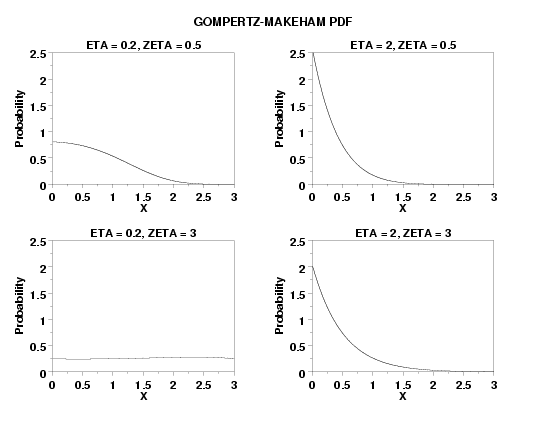

|
MAKPDFName:
There are a number of parameterizations of the Gompertz-Makeham distribution in the literature. Dataplot supports several different parameterizations.
The default parameterization is the Meeker and Escobar definition with two shape parameters. To specify the DLMF parameterization, enter the command
To specify the Meeker and Escobar parameterization with three shape parameters, enter the command
To reset the default Meeker and Escobar definition with two shape parameters, enter
The Gompertz-Makeham distribution can be generalized with location and scale parameters in the usual way. Simply replace x with (x-loc)/scale in the above equations.
<SUBSET/EXCEPT/FOR qualification> where <x> is a number, parameter, or variable; <eta> is a number, parameter, or variable that specifies the first shape parameter; <zeta> is a non-negative number, parameter, or variable that specifies the second shape parameter; <loc> is a positive number, parameter, or variable that specifies the location parameter; <scale> is a positive number, parameter, or variable that specifies the scale parameter; <y> is a variable or a parameter (depending on what <x> is) where the computed Gompertz-Makeham pdf value is stored; and where the <SUBSET/EXCEPT/FOR qualification> is optional. Note that the location and scale parameters are optional. This syntax implements the definition as given by Meeker and Escobar that reparameterizes the distribution to have only two shape parameters.
<SUBSET/EXCEPT/FOR qualification> where <x> is a number, parameter, or variable; <xi> is a positive number, parameter, or variable that specifies the XI shape parameter; <lambda> is a positive number, parameter, or variable that specifies the LAMBDA shape parameter; <theta> is a positive number, parameter, or variable that specifies the THETA shape parameter; <loc> is a positive number, parameter, or variable that specifies the location parameter; <scale> is a positive number, parameter, or variable that specifies the scale parameter; <y> is a variable or a parameter (depending on what <x> is) where the computed Gompertz-Makeham pdf value is stored; and where the <SUBSET/EXCEPT/FOR qualification> is optional. Note that the location and scale parameters are optional. This syntax implements the DLMF definition.
<SUBSET/EXCEPT/FOR qualification> where <x> is a number, parameter, or variable; <gamma> is a positive number, parameter, or variable that specifies the gamma shape parameter; <k> is a positive number, parameter, or variable that specifies the k shape parameter; <lambda> is a positive number, parameter, or variable that specifies the lambda shape parameter; <loc> is a positive number, parameter, or variable that specifies the location parameter; <scale> is a positive number, parameter, or variable that specifies the scale parameter; <y> is a variable or a parameter (depending on what <x> is) where the computed Gompertz-Makeham pdf value is stored; and where the <SUBSET/EXCEPT/FOR qualification> is optional. Note that the location and scale parameters are optional. This syntax implements the definition for three shape parameters as given by Meeker and Escobar.
LET A = MAKPDF(0.3,0.5,2) LET A = MAKPDF(X,ETA,ZETA) PLOT MAKPDF(X,ETA,ZETA) FOR X = 0.01 0.01 5
SET GOMPERTZ MAKEHAM DEFINITION DLMF
If the DLMF definition is used, define the parameters with the commands:
LET LAMBDA = <value> LET THETA = <value> If the three shape parameters Meeker and Escobar definition is used, define the parameters with the commands:
LET K = <value> LET LAMBDA = <value> If the two shape parameters Meeker and Escobar definition is used, define the parameters with the commands:
LET ZETA = <value> Then use the commands
GOMPERTZ MAKEHAM PROBABILITY PLOT Y GOMPERTZ MAKEHAM KOLMOGOROV SMIRNOV ...
If the two shape parameters Meeker and Escobar definition is used, the shape parameters can be estimated with the ks plot or ppcc plot:
LET ETA2 = <value> LET ZETA1 = <value> LET ZETA2 = <value> GOMPERTZ MAKEHAM KS PLOT Y GOMPERTZ MAKEHAM PPCC PLOT Y
2004/7: Added support for alternate parameterizations
Y1LABEL Probability
X1LABEL X
LABEL CASE ASIS
Y1LABEL DISPLACEMENT 12
X1LABEL DISPLACEMENT 12
TITLE DISPLACEMENT 2
YLIMITS 0 2.5
.
MULTIPLOT 2 2
MULTIPLOT CORNER COORDINATES 0 0 100 95
MULTIPLOT SCALE FACTOR 2
TITLE ETA = 0.2, ZETA = 0.5
PLOT MAKPDF(X,0.5,0.2) FOR X = 0.01 0.01 3
TITLE ETA = 2, ZETA = 0.5
PLOT MAKPDF(X,0.5,2) FOR X = 0.01 0.01 3
TITLE ETA = 0.2, ZETA = 3
PLOT MAKPDF(X,3,0.2) FOR X = 0.01 0.01 3
TITLE ETA = 2, ZETA = 3
PLOT MAKPDF(X,3,2) FOR X = 0.01 0.01 3
END OF MULTIPLOT
.
JUSTIFICATION CENTER
MOVE 50 97
TEXT Gompertz-Makeham PDF

Date created: 7/7/2004 |